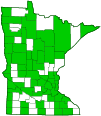common sunflower
(Helianthus annuus)
Conservation • Weed • Wetland • Description • Habitat • Ecology • Use • Distribution • Taxonomy
Description |
||
Common sunflower is an erect, annual forb that rises on a single stem from a taproot and fibrous roots. It can be 40″ to 120″ tall, but is usually no more than 80″ in height. The stem is erect, stout, ridged, light green to reddish-green, and leafy. It is round in cross section and is usually branched above the middle. The cultivated varieties are unbranched. It is moderately covered with short, stiff, ascending hairs. The hairs have a small, blister-like elevation at the base. The hairs on the lower stem often break off, leaving just the expanded base. There are usually 8 to 25 leaves on the stem. They are on ¾″ to 5″ long leaf stalks (petioles). The petioles has a channel on the upper (dorsal) surface, and is covered with short, stiff hairs. Only the lowermost leaves are opposite, the rest are alternate. The leaf blades are rough to the touch, like sandpaper. They are egg-shaped to triangular egg-shaped, 4″ to 16″ long, and 2″ to 40″ wide. They are wedge-shaped to heart-shaped at the base and taper to a usually sharp point at the tip. They are flat, not folded, and are often slightly drooping. They have 3 main veins, a central midrib and 2 lateral veins that branch from the midrib at the base. The upper and lower surfaces are moderately to densely covered with minute, firm, stiff, loosely appressed hairs. They are also sometimes moderately to densely dotted with stalkless yellow glands. The margins are finely to coarsely toothed, rarely almost untoothed. The leaves become much smaller and shorter stalked as they ascend the stem. The inflorescence is rarely a solitary flower head at the end of the stem. It is usually an open, branched cluster (panicle) of 2 to 9 flower heads. Each flower head is at the end of a ¾″ to 5″ long stalk. The flower heads are 3″ to 6″ in diameter. The cultivated varieties have a single, larger flower head. The whorl of modified leaves (bracts) at the base of the flower head (involucre) is half globe-shaped, ⅜″ to 1½″ long, and ⅝″ to 1½″ in diameter. The disk is flat and at least 1¼″ in diameter. On cultivated varieties the involucre is longer and much wider, up to 8″ or more in diameter. It is composed of 20 to 30 bracts (phyllaries) in 3 or 4 overlapping series. The phyllaries are egg-shaped to lance egg-shaped, ½″ to 1″ long, and 3 ⁄16″ to 5 ⁄16″ wide. They taper to a sharp, slender point at the tip with concave sides along the tip. The tips are usually spreading or bent backward. The outer surface is moderately to densely covered with stiff, short or long hairs and with small, stalkless glands. There are 17 to 30 ray florets and 150 or more disk florets. Cultivated varieties have up to 100 ray florets and up to 1,000 disk florets. The ray florets are yellow, 1″ to 2″ long, and sterile. The disk florets are reddish-brown to dark purple, sometimes yellow, and fertile. The fruit is a dry, one-seeded seed capsule (cypsela). The cypsela is purplish-black, more or less inversely pyramid-shaped, more or less flattened, ⅛″ to 3 ⁄16″ long, and hairless. There is no tuft of hairs attached to the end. |
||
Height |
||
20″ to 120″ |
||
Flower Color |
||
Yellow ray florets, reddish-brown to purple disk florets |
||
Similar Species |
||
|
||
Habitat |
||
Moist to slightly dry. Disturbed sites. Full sun. |
||
Ecology |
||
Flowering |
||
July to September |
||
Pests and Diseases |
||
Sunflower bullet gall midge (Pilodiplosis helianthibulla) makes ¼″ in diameter, almost globe-shaped galls on the leaves of plants in the genus Helianthus. |
||
Use |
||
Common sunflower is is used as a silage to feed livestock and as bird food, and it is sold as a snack food for humans. It is grown as an ornamental in gardens. It is used to create a cooking oil and a peanut butter alternative. Sunflowers grown by farmers are hybrids developed by crossing common sunflower with other species. Common sunflower is the state plant of Kansas. |
||
Distribution |
||||
|
Sources |
|||
| 4/2/2023 | ||||
Nativity |
||||
Native |
||||
Occurrence |
||||
Widespread |
||||
Taxonomy |
|||
| Kingdom | Plantae (Plants) | ||
| Division | Tracheophyta (Vascular Plants) | ||
| Subdivision | Spermatophytina (Seed Plants) | ||
| Class | Magnoliopsida (Dicots) | ||
Order |
Asterales (Sunflowers, Bellflowers, Fanflowers, and Allies) | ||
Family |
Asteraceae (Sunflowers, Daisies, Asters, and Allies) | ||
| Subfamily | Asteroideae | ||
| Supertribe | Helianthodae | ||
| Tribe | Heliantheae (Sunflowers and Allies) | ||
| Subtribe | Helianthinae | ||
| Genus | Helianthus (sunflowers) | ||
Subordinate Taxa |
|||
|
|||
Synonyms |
|||
Helianthus annuus ssp. jaegeri Helianthus annuus ssp. lenticularis Helianthus annuus ssp. texanus Helianthus annuus var. lenticularis Helianthus annuus var. macrocarpus Helianthus annuus var. texanus Helianthus aridus Helianthus lenticularis |
|||
Common Names |
|||
annual sunflower common sunflower Kansas sunflower mirasol garden sunflower sunflower wild sunflower |
|||
Glossary
Bract
Modified leaf at the base of a flower stalk, flower cluster, or inflorescence.
Cypsela
A dry, one-chambered, single-seeded fruit, formed from a single carpel, with the seed attached to the membranous outer layer (wall) only by the seed stalk; the wall, formed from the wall of the inferior ovary and also from other tissues derived from the receptacle or hypanthium, does not split open at maturity, but relies on decay or predation to release the contents.
Involucre
A whorl of bracts beneath or surrounding a flower, flower head, or flower cluster.
Panicle
A pyramidal inflorescence with a main stem and branches. Flowers on the lower, longer branches mature earlier than those on the shorter, upper ones.
Petiole
On plants: The stalk of a leaf blade or a compound leaf that attaches it to the stem. On ants and wasps: The constricted first one or two segments of the rear part of the body.
Phyllary
An individual bract within the involucre of a plant in the Asteraceae family.
Visitor Photos |
|||||
Share your photo of this plant. |
|||||
| This button not working for you? Simply email us at info@MinnesotaSeasons.com. Attach one or more photos and, if you like, a caption. |
|||||
|
|||||
MinnesotaSeasons.com Photos |
|||||
|
|||||
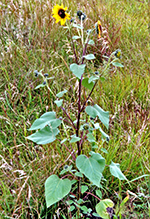 |
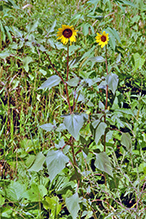 |
||||
Plant |
Plant |
||||
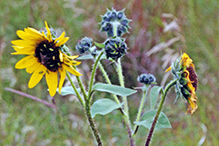 |
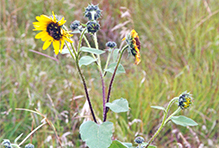 |
||||
Inflorescence |
Inflorescence |
||||
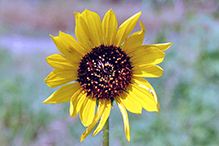 |
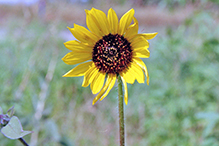 |
||||
Flower head |
Flower head |
||||
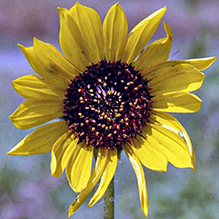 |
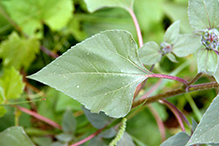 |
||||
Leaves |
|||||
|
|||||
|
|||||
Flower head |
|
||||
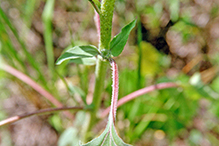 |
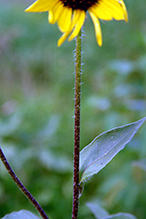 |
||||
Petiole |
|||||
|
|||||
|
|||||
|
Stem |
||||

Slideshows |
||
| Helianthus annus Susanne Wiik |
||
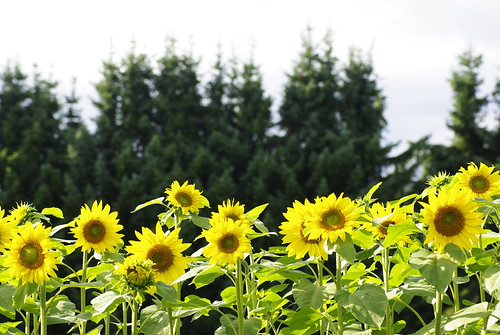
|
||
About
Solsikke |
||
| Helianthus annuus Matt Lavin |
||
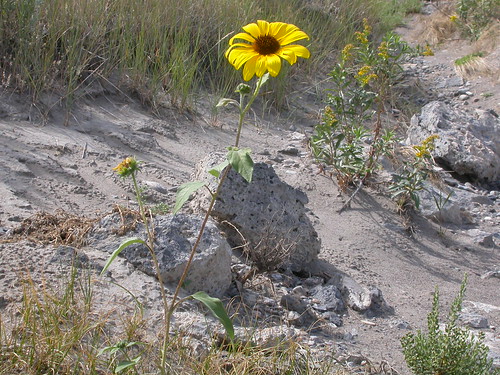
|
||
About
Native taprooted annuals to about 1 m tall, leaves essentially ovate, receptacle chaffy, all receptacle bracts lacking long white hairs at tip, pappus of two deciduous scales, flowering during the late season, common in disturbed sites from low to middle elevations, especially abundant along roadsides. |
||

Visitor Videos |
|||
Share your video of this plant. |
|||
| This button not working for you? Simply email us at info@MinnesotaSeasons.com. Attach a video, a YouTube link, or a cloud storage link. |
|||
Other Videos |
|||

Visitor Sightings |
|||||
Report a sighting of this plant. |
|||||
| This button not working for you? Simply email us at info@MinnesotaSeasons.com. Be sure to include a location. |
|||||
|
|||||
MinnesotaSeasons.com Sightings |
|||||

|
Created: 8/27/2004 Last Updated: © MinnesotaSeasons.com. All rights reserved. |
